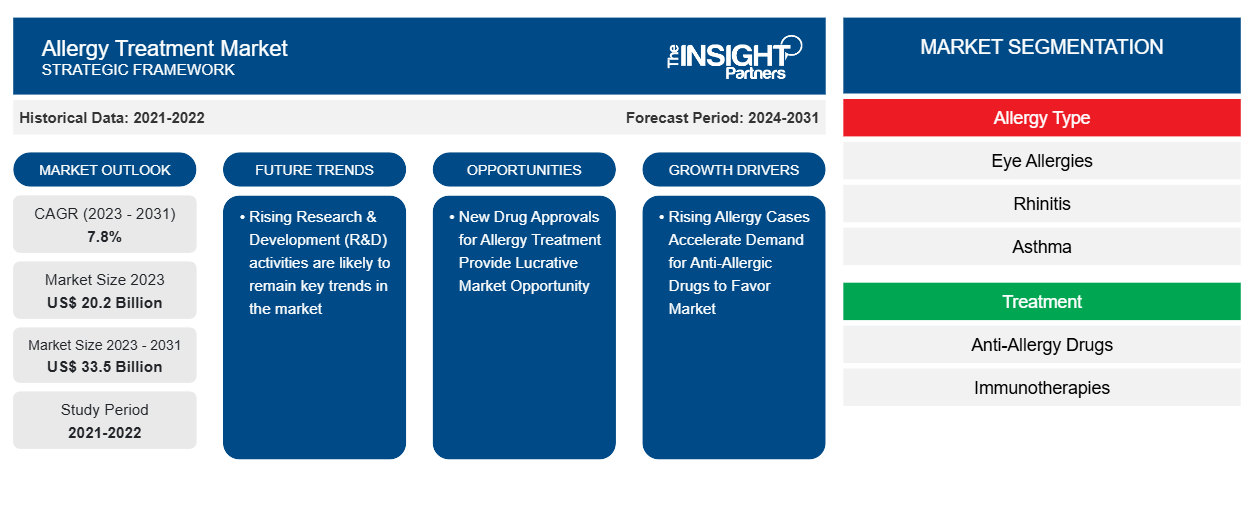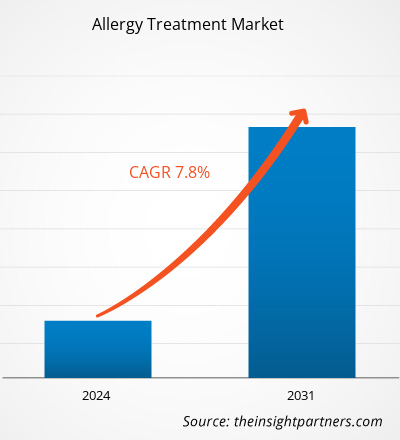Allergy Treatment Market Drivers and Forecasts by 2031
Historic Data: 2021-2022 | Base Year: 2023 | Forecast Period: 2024-2031Allergy Treatment Market Size and Forecast (2021 - 2031), Global and Regional Share, Trend, and Growth Opportunity Analysis Report Coverage: By Allergy Type (Eye Allergies, Rhinitis, Asthma, Skin Allergies, Food Allergies, and Others), Treatment (Anti-Allergy Drugs and Immunotherapies), and Geography
- Report Date : Feb 2026
- Report Code : TIPRE00004584
- Category : Life Sciences
- Status : Data Released
- Available Report Formats :


- No. of Pages : 150
The allergy treatment market size is projected to reach US$ 33.5 billion by 2031 from US$ 20.2 billion in 2023. The market is expected to register a CAGR of 7.8% during 2023–2031. Rising Research & Development (R&D) activities are likely to remain key trends in the market.
Allergy Treatment Market Analysis
Rising R&D activities for allergy treatment to develop innovative drugs is likely to remain as a new market trend in the coming years. Despite several allergic medicines in the market, still many patients with respiratory allergies and asthma are not adequately controlled or are insufficiently treated with symptomatic therapy. For example, several respiratory allergies are a risk of developing asthma. Therefore, several top manufacturers are designing clinical trial programs for allergies. HAL Allergy B.V.'s "Allergen Immunotherapies" for respiratory allergies for a clinical trial is an example. Therefore, rising R&D activities will result in the development of novel anti-allergic drugs will account considerable market growth during 2021-2031.
Allergy Treatment Market Overview
According to the Asthma Allergy Clinic report, new data published by the World Allergy Organization (WAO) reveals that 14% of people have asthma, with 20% suffering from allergic rhinitis (AR), which results in IgE-mediated inflammation of the nasal mucosa. Currently, about 20-30% of the people in India have one or more allergic diseases, and the prevalence will rise in the coming years. Therefore, rising cases of allergies will accelerate demand for antiallergic drugs in the coming decade.
Customize This Report To Suit Your Requirement
You will get customization on any report - free of charge - including parts of this report, or country-level analysis, Excel Data pack, as well as avail great offers and discounts for start-ups & universities
Allergy Treatment Market: Strategic Insights

-
Get Top Key Market Trends of this report.This FREE sample will include data analysis, ranging from market trends to estimates and forecasts.
Allergy Treatment Market Drivers and Opportunities
Rising Allergy Cases Accelerate Demand for Anti-Allergic Drugs to Favor Market
According to the American Academy of Pediatrics report, the most common type of allergy is Hay Fever (allergic rhinitis), which accounts for the high cost of treatment. For example, the direct and indirect costs exceed US$7 billion annually for allergy treatment. Therefore, good allergy treatment is based on medical history, results of allergy tests, and with symptoms mild or severe. Additionally, immunotherapy is an effective treatment option for some allergy patients. There are two common types of immunotherapy. These include allergy shots and sublingual immunotherapy (SLIT). Allergy shots include giving injection of allergens with; an increasing dose over time. Also, the person progressively less sensitive to that allergen as these shots can work well for some people with allergies to pollen, pets, dust, bees, and other stinging insects, as well as asthma. Therefore, rising allergy cases accelerate demand for anti-allergic drugs acting as the major drivers for global allergy treatment market share.
New Drug Approvals for Allergy Treatment Provide Lucrative Market Opportunity
New drug approvals to treat allergy treatments will provide lucrative market opportunity for the allergy treatment market. In June 2020, Cadila Pharmaceuticals Limited announced the launching of "Bilastine Syrup (30ml)" and Bilastine Tablets of 20mg strength. Additionally, in March 2022, Perrigo Company plc announced receiving final approval from the USFDA for over-the-counter (OTC) use of "Nasonex® 24HR Allergy (mometasone furoate monohydrate 50mcg)". The approval marks the first branded Rx-to-OTC switch for the company for "Nasonex" to enter the OTC marketplace.
Allergy Treatment Market Report Segmentation Analysis
Key segments that contributed to the derivation of the allergy treatment market analysis are type, cause, disorder type, category, and end user.
- Based on allergy type, the allergy treatment market is segmented as eye allergies, rhinitis, asthma, skin allergies, food allergies, and others. The rhinitis segment held a larger market share in 2023.
- By treatment, the market is segmented into anti-allergy drugs and immunotherapies. The anti-allergy drugs segment held the largest share of the market in 2023.
Allergy Treatment Market Share Analysis by Geography
The geographic scope of the Allergy Treatment market report is mainly divided into five regions: North America, Asia Pacific, Europe, Middle East & Africa, and South & Central America.
North America has dominated the market. In North America region, the US accounts largest share for allergy treatment market. Presence of top manufacturers in the region and their innovative anti-allergic drugs having effective pharmacological activity are the factors contributing to the dominance of the market. Asia Pacific is anticipated to grow with the highest CAGR in the coming years.
Allergy Treatment Market Regional Insights
The regional trends and factors influencing the Allergy Treatment Market throughout the forecast period have been thoroughly explained by the analysts at The Insight Partners. This section also discusses Allergy Treatment Market segments and geography across North America, Europe, Asia Pacific, Middle East and Africa, and South and Central America.
Allergy Treatment Market Report Scope
| Report Attribute | Details |
|---|---|
| Market size in 2023 | US$ 20.2 Billion |
| Market Size by 2031 | US$ 33.5 Billion |
| Global CAGR (2023 - 2031) | 7.8% |
| Historical Data | 2021-2022 |
| Forecast period | 2024-2031 |
| Segments Covered |
By Allergy Type
|
| Regions and Countries Covered |
North America
|
| Market leaders and key company profiles |
|
Allergy Treatment Market Players Density: Understanding Its Impact on Business Dynamics
The Allergy Treatment Market is growing rapidly, driven by increasing end-user demand due to factors such as evolving consumer preferences, technological advancements, and greater awareness of the product's benefits. As demand rises, businesses are expanding their offerings, innovating to meet consumer needs, and capitalizing on emerging trends, which further fuels market growth.

- Get the Allergy Treatment Market top key players overview
Allergy Treatment Market News and Recent Developments
The Allergy Treatment market is evaluated by gathering qualitative and quantitative data post primary and secondary research, which includes important corporate publications, association data, and databases. A few of the developments in the Allergy Treatment market are listed below:
- In February 2024, Novartis announced US Food and Drug Administration (USFDA) approval of "Xolair (omalizumab)". The newly launched product is used for the reduction of allergic reactions, including anaphylaxis occurring with accidental exposure to one or more foods in adult and paediatric patients aged 1 year and older with IgE-mediated food allergy. (Source: Novartis, Company Website, February 2024)
Allergy Treatment Market Report Coverage and Deliverables
The “Allergy Treatment Market Size and Forecast (2021–2031)” report provides a detailed analysis of the market covering below areas:
- Allergy treatment market size and forecast at global, regional, and country levels for all the key market segments covered under the scope
- Allergy Treatment market trends as well as market dynamics such as drivers, restraints, and key opportunities
- Detailed PEST/Porter’s Five Forces and SWOT analysis
- Allergy Treatment market analysis covering key market trends, global and regional framework, major players, regulations, and recent market developments
- Industry landscape and competition analysis covering market concentration, heat map analysis, prominent players, and recent developments for the Allergy Treatment market
- Detailed company profiles
Frequently Asked Questions
Which region dominated the allergy treatment market in 2023?
What are the driving factors impacting the allergy treatment market?
What are the future trends of the allergy treatment market?
Which are the leading players operating in the allergy treatment market?
What would be the estimated value of the allergy treatment market by 2031?
What is the expected CAGR of the allergy treatment market?
Mrinal is a seasoned research analyst with over 8 years of experience in Life Sciences Market Intelligence and Consulting. With a strategic mindset and unwavering commitment to excellence, she has built deep expertise in pharmaceutical forecasting, market opportunity assessment, and developing industry benchmarks. Her work is anchored in delivering actionable insights that empower clients to make informed strategic decisions.
Mrinal’s core strength lies in translating complex quantitative datasets into meaningful business intelligence. Her analytical acumen is instrumental in shaping go-to-market (GTM) strategies and uncovering growth opportunities across the pharmaceutical and medical device sectors. As a trusted consultant, she consistently focuses on streamlining workflow processes and establishing best practices, thereby driving innovation and operational efficiency for her clients.
- Historical Analysis (2 Years), Base Year, Forecast (7 Years) with CAGR
- PEST and SWOT Analysis
- Market Size Value / Volume - Global, Regional, Country
- Industry and Competitive Landscape
- Excel Dataset
Recent Reports
Testimonials
The Insight Partners' SCADA System Market report is comprehensive, with valuable insights on current trends and future forecasts. The team was highly professional, responsive, and supportive throughout. We are very satisfied and highly recommend their services.
RAN KEDEM Partner, Reali Technologies LTDsI requested a report on a very specific software market and the team produced the report in a few days. The information was very relevant and well presented. I then requested some changes and additions to the report. The team was again very responsive and I got the final report in less than a week.
JEAN-HERVE JENN Chairman, Future AnalyticaWe worked with The Insight Partners for an important market study and forecast. They gave us clear insights into opportunities and risks, which helped shape our plans. Their research was easy to use and based on solid data. It helped us make smart, confident decisions. We highly recommend them.
PIYUSH NAGPAL Sr. Vice President, High Beam GlobalThe Insight Partners delivered insightful, well-structured market research with strong domain expertise. Their team was professional and responsive throughout. The user-friendly website made accessing industry reports seamless. We highly recommend them for reliable, high-quality research services
YUKIHIKO ADACHI CEO, Deep Blue, LLC.This is the first time I have purchased a market report from The Insight Partners.While I was unsure at first, I visited their web site and felt more comfortable to take the risk and purchase a market report.I am completely satisfied with the quality of the report and customer service. I had several questions and comments with the initial report, but after a couple of dialogs over email with their analyst I believe I have a report that I can use as input to our strategic planning process.Thank you so much for taking the extra time and making this a positive experience.I will definitely recommend your service to others and you will be my first call when we need further market data.
JOHN SUZUKI President and Chief Executive Officer, Board Director, BK TechnologiesI wish to appreciate your support and the professionalism you displayed in the course of attending to my request for information regarding to infectious disease IVD market in Nigeria. I appreciate your patience, your guidance, and the fact that you were willing to offer a discount, which eventually made it possible for us to close a deal. I look forward to engaging The Insight Partners in the future, all thanks to the impression you have created in me as a result of this first encounter.
DR CHIJIOKE ONYIA MANAGING DIRECTOR, PineCrest Healthcare Ltd.Reason to Buy
- Informed Decision-Making
- Understanding Market Dynamics
- Competitive Analysis
- Identifying Emerging Markets
- Customer Insights
- Market Forecasts
- Risk Mitigation
- Boosting Operational Efficiency
- Strategic Planning
- Investment Justification
- Tracking Industry Innovations
- Aligning with Regulatory Trends




















 Get Free Sample For
Get Free Sample For